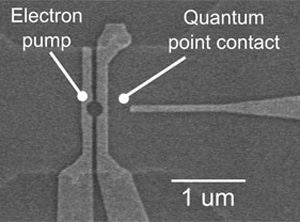Mar 15 2016
Scientists from the National Physical Laboratory (NPL) have demonstrated the ability to detect the presence or absence of individual electrons with unprecedented accuracy.
 Electron microscope picture of the device used to study single electrons. Electrons are trapped in the circular cut-out region and counted by measuring the current flowing through the quantum point
contact on the right. The horizontal scale bar indicates 1 micrometre (a thousandth of a millimetre)
Electron microscope picture of the device used to study single electrons. Electrons are trapped in the circular cut-out region and counted by measuring the current flowing through the quantum point
contact on the right. The horizontal scale bar indicates 1 micrometre (a thousandth of a millimetre)
The technique, developed by Dr Stephen Giblin and researchers from NPL's Quantum Detection Group and the University of Cambridge, is capable of counting the number of electrons trapped in an electron pump – a small region of a specially designed semiconductor device – with a fidelity of one part per million. The sensitivity of the counting technique, described in a paper published in Applied Physics Letters, has enabled the researchers to spot rare errors in which the wrong number of electrons are loaded into the pump.
A new partner for the ampere
Electron pumps are nanoscale devices which can trap and manipulate individual electrons – the carriers of electrical charge. By driving these electrons around a circuit, we can use electron pumps to generate an incredibly precise current, which could be the basis of a new definition of the ampere – the SI base unit of electrical current. Currently, the ampere's definition in terms of two infinitely long conductors makes it difficult to realise in practice, and several National Measurement Institutes, including NPL, are developing electron pumps for use as the new primary standard of electrical current
The Quantum Detection Group at NPL has been a leading player in the field since their landmark demonstration in 2012 of a pump capable of driving one electron every nanosecond (a billion electrons per second) with part-per-million accuracy. Crucially however, this experiment and follow-up experiments at other labs, relied on comparing the electron pump current with a conventional current standard. Its accuracy, while impressive, was limited by the accuracy of the conventional current standard, not the pump itself.
To be absolutely sure of electron pumps' accuracy – a prerequisite to the introduction of any new primary standard – Dr Giblin's team set out to investigate the pump independently of existing current standards, by counting how many electrons it loads in each cycle of its operation.
One million electrons and counting
Previous electron counting techniques have attempted to measure the number of electrons coming out of the pump. In these experiments, the electrons are dispersed over a relatively large area, and this compromises the sensitivity of the detection.
In contrast, the NPL and Cambridge team used a nanoscale charge detector called a 'quantum point contact' to directly measure the number of electrons inside the pump. Here, the electrons are confined in a small area, a circle roughly 250 nanometres in diameter, and their charge is easier to detect. After devising a method to cancel out most of the noise intrinsic to all electronic devices, the team now had the capability to count the electrons inside the pump with a fidelity approaching one part in a million.
The experiment immediately yielded new insights – for example, when the team attempted to load one electron into the pump one million times, the electron failed to load 28 times – a common type of error due to a process called 'back-tunnelling'. However, there were five cases where the pump loaded two electrons.
"Previously, we could only measure average current, now we can really see how many electrons are there with a very high level of confidence," said Dr Giblin.
The team also tuned the pump to try and load two electrons a million times, and observed only one error (when the pump loaded one electron) - this marks a factor of 100 improvement over the best previous result.